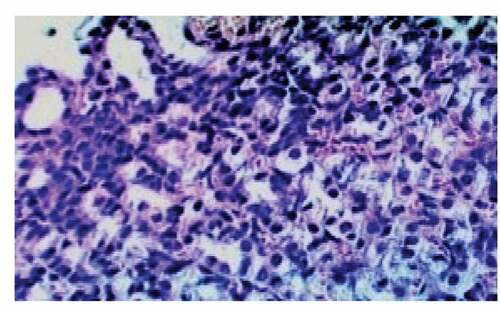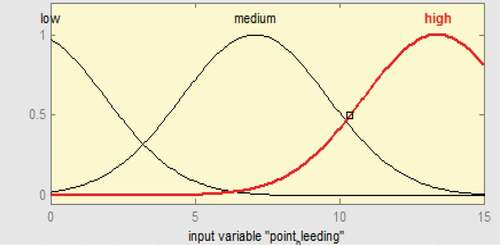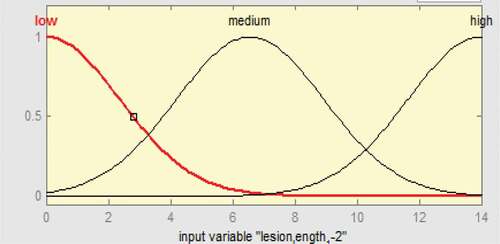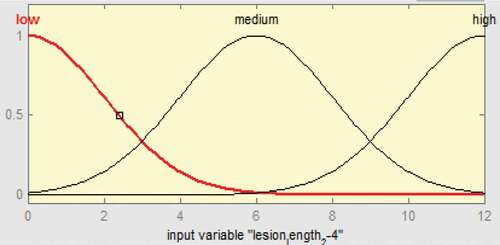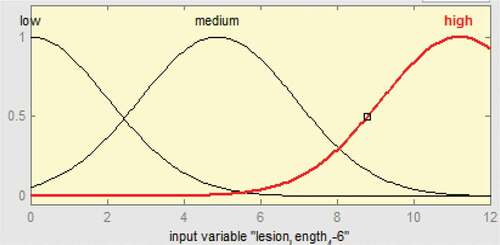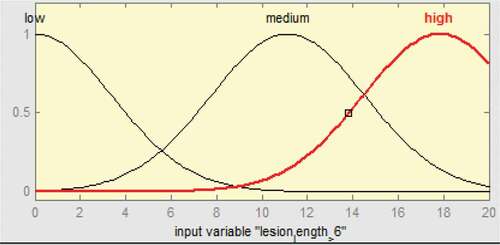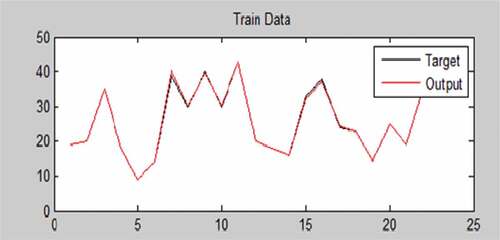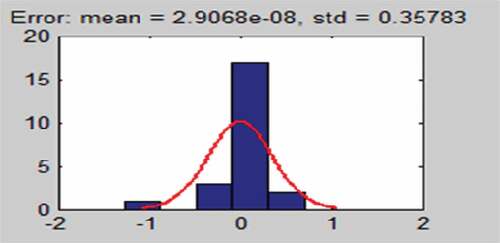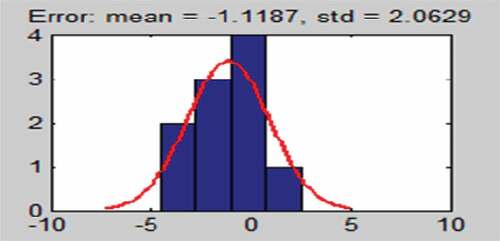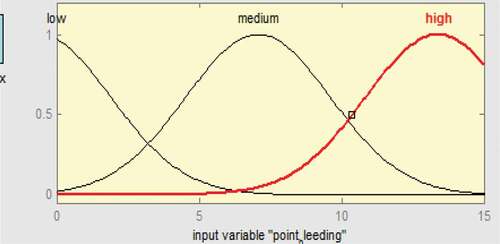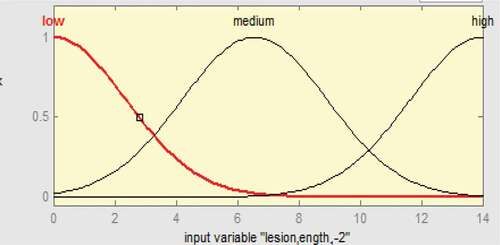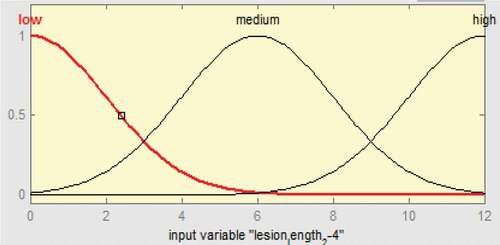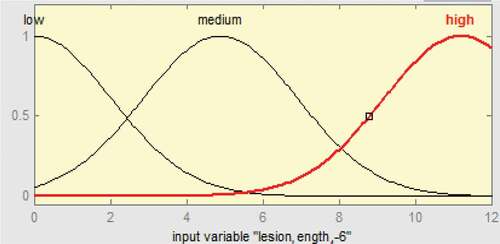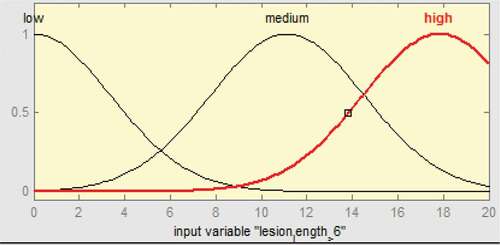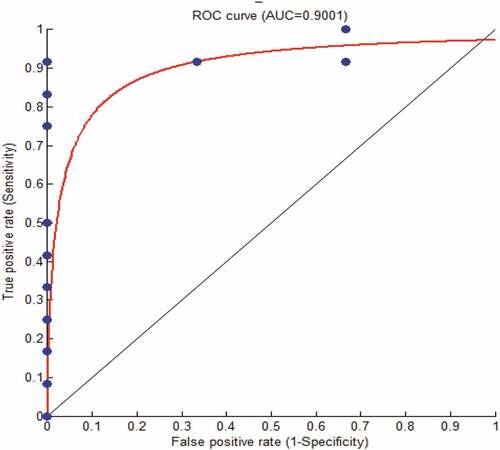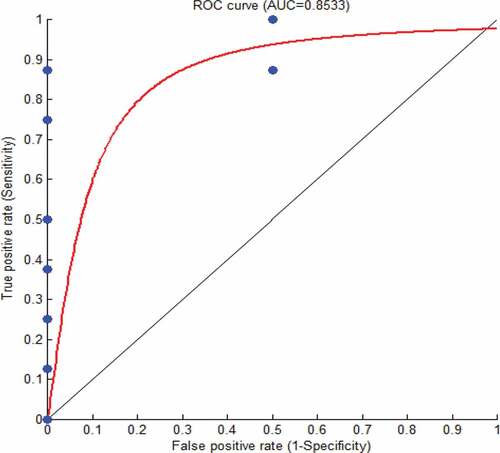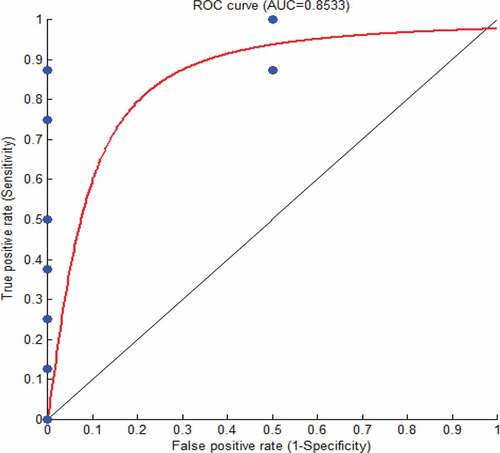 ?Mathematical formulae have been encoded as MathML and are displayed in this HTML version using MathJax in order to improve their display. Uncheck the box to turn MathJax off. This feature requires Javascript. Click on a formula to zoom.
?Mathematical formulae have been encoded as MathML and are displayed in this HTML version using MathJax in order to improve their display. Uncheck the box to turn MathJax off. This feature requires Javascript. Click on a formula to zoom.Abstract
Peptic ulcer disease causes abdominal discomfort and pain. Helicobacter pylori bacteria, infection and long-term use of anti-inflammatory drugs are the most common causes of peptic ulcers. Untreated ulcers can lead to other more serious health complications. Gastric cancer is the second commonest cause of death from malignant disease. Speed performance is always quietly essential in detecting and treating peptic ulcer. Combining artificial intelligence with medical knowledge provides a faster and more accurate diagnosis. The main purpose of this study is to design a novel, inexpensive, reliable and quick Fuzzy Expert System for diagnosis of peptic ulcer disease. A data set of 101 Male adult Wistar rats with a weight range of 200–250 g were obtained from the Pasteur institute. Peptic ulcer induced by Indomethacin (50 mg/kg, 2 ml). A computational approach based on a Fuzzy Inference System (FIS) is suggested in this study for the evaluation of peptic ulcer. The Fuzzy Inference System was produced with Fuzzy C-Means and tuned using the Adaptive Neuro-Fuzzy Inference System model (ANFIS). In order to compare the two methods, the performance of the FIS was evaluated with a ROC curve that prepares the FCM accuracy of 90% and ANFIS accuracy of 85%. In conclusion, the Fuzzy Expert System can potentially increase the accuracy and efficiency of medical practices for peptic ulcer diseases to move towards more precision medicine and treatment. This applicable Fuzzy system may impact hospitals and health systems in improving efficiency and productivity, while reducing the cost of care. It can also be considered in medicine to reduce manual tasks and human error.
PUBLIC INTEREST STATEMENT
Gastric ulcer is one of the most common diseases in society, but its physiopathology is not well understood. The progression of the disease and its penetration into other parts of the gastrointestinal tract can lead to gastric cancer. For this reason, researchers in laboratories are looking for different ways of curing the disease, in which experiments on the stomach of mice have been done to achieve the desired result. The length of the rats’ stomach ulcer indicates the severity of their ulcer. Determination of the severity of gastric ulcer depends on many factors that are measured with inaccuracy and ambiguity. Therefore, it is necessary to have an intelligent system for the classification and determination of the severity of gastric ulcer under uncertainty by experts. Recently complementary multidisciplinary sciences such as medicine, computer diagnostic tools, artificial intelligence and fuzzy systems have increased accuracy to find out stage and type of various disease.
1. Introduction
Artificial intelligence in computer science identifies meaningful relationships in raw data. It assists scientists to solve almost impossible problems. Physicians spend too much time n engaging with patients to figure out solutions. Physicians are interested in determining whether the patient under checkup is showing signs of a benign or malignant type of illnesses (Pereira et al., Citation2019; Wilson et al.,). Initially, William B Schwartz was interested in the use of computing science in medicine to reach better results and decisions (Schwartz, Citation1970). So the idea of using a predictive computer system is not new, but so far, these systems are not sufficiently applicable in health centers specially in the ulcer disease area. It is complicated to reach conclusions about the patient’s symptoms with complexities (Sittig et al., Citation1989). Critical decisions are made based on a set of observations and measurements. A physician evaluates all factors mentally to achieve the best diagnosis. However, there are various difficulties in analyzing a large amount of histopathologic and clinical information in the field of medicine (Donabedian, Citation2005). Therefore, complementary methods are required for a better diagnosis. New methods are suggested to the physicians by computer experts via machine learning methods to assist in decision-making procedures (Güvenir et al., Citation2004). These methods can be used to support diagnosing, treating and predicting outcomes in many medical situations. However, the concern is a shortage of scientists with both biomedical algorithm building proficiency and knowledge. Currently, due to cancer complication, the main purpose for such smart tools is in the scope of cancer recognition such as gastric cancer. Early detection of gastric ulcer facilitates the process of gastric cancer treatment. The use of an expert system along with physicians' knowledge will aid to treat cancer faster and reduce human errors (Matthijs et al., Citation2016). Over the past few decades, the computerized diagnostic tools, intended to aid the physician in making sense out of the welter of data (Abbass, Citation2002). Nowadays, the main topic of medical science is a diagnosis of illness based on several experiments (Fried et al., Citation1991). Multidisciplinary science stream such as medicine and computer diagnostic tools may increase accuracy to find out the stage and type of disease (Pena-Reyes & Sipper, Citation1999).
Promising progress is achieved through medicine, artificial neural network and fuzzy logic as a part of artificial intelligence (Torchio et al., Citation1989). Computer aided diagnostics (CAD) is a concept based on computer algorithms (Giger & MacMahon, Citation1996). CAD tools have become one of the key issues in medical imaging (Aghaei et al., Citation2017, March). CAD is a concept established by taking equally into account the knowledge of doctors and computer science, while automated computer diagnostics are a concept based solely on computer algorithms (Giger & MacMahon, Citation1996). Using CAD, the performance of computers should not be comparable to or better than the doctors, but doctors should complement each other. In fact, a wide number of CAD tools have been applied recently in the early detection of cancers (Doi, Citation2007). A novel classification algorithm, called Benefit Maximizing Classifier on Feature Projections (BCFP), is also used for gastric carcinoma tumor recognition. The domain contains studies and records of patients with a known diagnosis by gastroscopy results. The BCFP training algorithm input is a set of training instances describing subjects with known diagnosis. Regarding the training set of such records, the BCFP classifier learns how to distinguish a new case in the mentioned domain (Güvenir, Citation2003). Classification in the BCFP algorithm is based on voting among the individual predictions made on each feature. In gastric carcinoma, an ulcer can be indicator of different levels from 1 early to 9 end stage. The BCFP algorithm in the training phase learns classification rules which maximizes classification benefit (Güvenir, Citation2003). The BCFP algorithm tries to make a logical prediction by maximizing the profit at the query phase. A genetic algorithm is also applied to choose the relevant features. The BCFP algorithm gained high accuracy on the gastric carcinoma data set.
Medical technology is a range of tools that can enable health professionals to provide patients and society with a better quality of life. The medical technology reduces the length of hospitalization by performing early diagnosis, reducing complications, optimizing treatment and providing less invasive options. As a part of medical technology, this study evaluates the severity of peptic ulcer using a Fuzzy Expert System.
A peptic ulcer is one of the essential diagnosis concerns (Lanas & Chan, Citation2017). Peptic ulcer illness involving duodenal and gastric ulcer is the most common gastrointestinal disorderliness (Laine & Peterson, Citation1994; Umashanker & Shruti, Citation2011). A peptic ulcer is a lesion in the lining mucosa of the digestive tract, typically in the stomach or duodenum. It is caused by the digestive action of pepsin and stomach acid. Different factors such as Helicobacter pylori can cause gastrointestinal ulcers (Fashner & Gitu, Citation2015). Helicobacter pylori is a type of bacteria that can cause stomach infections and inflammation (Malfertheiner et al., Citation2017). Gastroenterologists decide based on diagnostic, therapeutic and monitoring problems (Quinlan, Citation1986). In health-care procedures diagnostic part is started by evaluating clinical data from physical examination and patient history. The diagnostic hypotheses given at this level are refined and ultimately confirmed with more information in the following part. Disease classes are defined as erosive gastritis, gastro-oesophagealreflux, chronic antral gastritis, and peptic ulcer (Umashanker & Shruti, Citation2011). Frequent use of drugs, smoking, alcohol, radiation therapy, and gastric cancer are among other causes of ulcers (Ramakrishnan & Salinas, Citation2007). Furthermore, it is important to note that suggested pharmaceutical products for gastric ulcers are not occasionally effective. To the best of our knowledge, numerous unfavorable symptoms are reported as a result of using them. Nowadays, the focus on herbal studies represents a high potential application of medicinal herbs in this field (Pena-Reyes & Sipper, Citation1999). It is valuable to diagnose disease according to the symptoms at an early stage to treat by either chemical or herbal medications.
Although other studies applied various computer techniques for quick and accurate decision-making of diseases, none of them has specifically examined peptic ulcers so far. Therefore, the goal of this study is to introduce an effective Fuzzy Expert System for fast and accurate diagnosis of ulcer diseases. The output of this project will actually be a promising application of computer technology, knowledge and human skill strengths in medical professionals.
2. Materials and methods
The research method and data collection in this study were conducting anatomical tests on the studied rats. Such data included the length of gastric ulcer from Tehran University of Medical Sciences, Iran.
2.1. Animals
Male adult Wistar rats with a weight range of 200–250 g were obtained from the Pasteur Institute, Iran. Animal experiments were performed in accordance with national guidelines for the use and care of laboratory animals and approved by the local animal care committee of Tehran University of Medical Sciences. In order to perform the experiments, the rats were fed with pre-made specific food as well as water. The rats were kept in an animal room at 25°C for 12 h of lighting and 12 h of darkness to adapt to the environment for 3 days. 24 h before starting the test, the animals were put in special cages with no straw. There was no access to the feces and urine of the animals. During this period, the rats only drank water. The stomach of each animal was completely free from any food.
2.2. Chemical method of causing gastric ulcer
Peptic ulcer induced by Indomethacin. Indomethacin powder was prepared from DarouPakhsh company. Samples (rat) were given 1 h before the i.p. administration of Indomethacin as a nonsteroidal anti-inflammatory drug. It is suspended in saline (50 mg/kg, 2 ml) (Moghaddam et al., Citation2013).
2.3. Ulcer index measurement
In order to diagnose and determine ulcer intensity causing by Indomethacin, the stomachs of the rats were removed. Then the ulcer index was measured using loop and eye graticule. Data from this study included the length of the measured ulcers from the stomach of the rats being considered as input parameters. Ulcer index as an output parameter is defined as follows:
W1: Each 5 petechia points were considered as a 1 mm ulcer and received factor 1
W2: The number of ulcers with lengths from 1 to 2 mm received factor 2
W3: The number of ulcers with lengths from 2 to 4 mm received factor 3
W4: The number of ulcers with lengths from 4 to 6 mm received factor 4
W5: The number of ulcers with lengths from 6 mm and above received factor 5
Using EquationEquation 1(1)
(1) , the severity of the rat gastric ulcer was calculated with respect to the created ulcers.
The intensity of the gastric ulcer was calculated using the above mentioned equation.
2.4. Data-sets
The number of studied samples in this study was 101. Regarding the effect of Indomethacin on the stomach of each rat, we have obtained a different number of data sets. So that in the stomach of some rats there are fewer ulcers and in others more ulcers. The range of final data has been extracted from 9 to 50 records with different lesion lengths from the stomach of each rat. Ulcer length was measured using loop and eye graticule. Data from this study included the length of the measured ulcers from the stomach of the rats being considered as input parameters.
indicates created ulcers in the stomach of five rats and calculating method as well.
Table 1. Five samples of the parameters obtained from rat gastric ulcer
The images of the damaged tissues of the stomach and created ulcers in were measured by eye graticule.
2.5. Histological studies
The images were obtained from multiple slides in a microscope sub-loop being required for the microscopic examination and comparison of the required groups. The number proportional to the histological observation is conventional. Highly severe bleeding was reported as +4, severe bleeding as +3, average bleeding as +2, and mild bleeding as +1 ().
2.6. Fuzzy expert system
This section briefly explains the main components of a Fuzzy Expert System including: membership functions, fuzzy rule base, fuzzification and defuzzification. The FIS is a rule-based system that uses fuzzy logic, rather than Boolean logic, to reason the best results (Abraham, Citation2005). As depicted in basic structure of FIS includes four main components, including fuzzifier unit, fuzzy inference unit, defuzzifier unit and knowledge base (Pena-Reyes & Sipper, Citation1999).
Fuzzy set A can be determined as follows (Zadeh, Citation1994):
The most important application of fuzzy logic is to deal with uncertainty (Neshat et al., Citation2008). When a problem has a dynamic behavior, fuzzy logic is a good solution (Neshat et al., Citation2008; Saritas et al., Citation2003). The first phase of Fuzzy Expert System designing is the determination of input/output variables (De Silva, Citation2018). There are one output variable and five input variables. Then Membership Function MF of all variables should be designed. Membership of objects to fuzzy sets is determined by membership functions (Kandel, Citation1991). In the first step, the input variables are described with their MFs. In the second step, the output variables with its membership functions are also introduced. Finally, in the last section, the rules of the system are presented (Adeli & Neshat, Citation2010).
3. Results and disscussion
Assessment of experimentally induced gastric ulcers is a complicated task because of their irregularly shaped and multiple incidences. For chemical-induced ulcer quantification, the cumulative length of all hemorrhagic erosion was described as the easiest form of ulcer index. The ulcer width has also been accounted. Ulcer index (mm) = length-width (Moghaddam et al., Citation2013). A Fuzzy Expert System for the recognition of peptic ulcer disease has been proposed in this study. The designed system has been evaluated and compared with the knowledge of the medical experts. Three experts assisted to design the system.
3.1. Input-output variables
Stomachs of rats were opened along the greater curvature. The gastric mucosal lesions were expressed in terms of ulcer index (UI) according to Peskar et al. (Citation2002). Microscopic observation of the lesions in the glandular portion was examined for ulcer area by three investigators. The severity factor for each FIS input variable was defined according to the length of the lesions (). The severity of mucosal lesions was scored as low, medium and high as described in section 2.3. Ulcer index was also considered as output variables of FIS in this project.
Table 2. Input variables of the FIS
3.2. Methods
The Fuzzy Expert System for peptic ulcer diagnosis was implemented in the fuzzy logic toolbox in Matlab. Following methods have been applied according to the FIS to evaluate the intensity of peptic ulcer.
Fuzzy C-Means Clustering FCM, applied in order to the automatic generation of the membership functions and scatter partitioning of the input space. The FCM starts with a preliminary guess for the cluster centers. It allows one piece of data to belong to two or more clusters. Which are supposed to mark the mean location of each cluster. The preliminary guess for these cluster centers is most in all likelihood wrong. The FCM assigns every data point a membership grade for each cluster. Clusters are identified by similarity measures including distance, connectivity, and intensity. With the aid of iteratively updating the cluster centers and the membership grades for every data point, FCM iteratively moves the cluster centers to the right location inside a data set. This iteration is based on minimizing an objective function that represents the distance from any given data point to a cluster center, weighted through that data point’s membership grade. Fuzzy C-Means has been an essential tool for image processing in clustering objects in an image (Bezdek et al., Citation1984).
Adaptive Neuro-Fuzzy Inference System ANFIS applied in order to the tuning of the membership functions and learning the FIS rules. The ANFIS utilizes a hybrid learning algorithm to recognize parameters of the Sugeno type fuzzy inference system. It integrates both neural networks and fuzzy logic principles and it has the potential to capture the benefits of both in a single framework. ANFIS applies a mix of the backpropagation method and the least-squares method for training FIS membership function parameters to emulate a given training data set. ANFIS can also be invoked using an optional argument for model validation (Jang, Citation1993).
In the procedure of specifying the FIS parameter with the ANFIS model, a data set containing 101 Wistar male rats with diagnosed peptic ulcer. The data set was divided into two sections:
1. 30% for testing
2. 70% for training
The membership functions and rules of the FIS for peptic ulcer risk evaluation were designed with Fuzzy C-Means FCM clustering via extracting the collection of rules. It can model the data behavior with ANFIS Toolbox and Fuzzy Logic Toolbox (). Initially, the rule extraction technique used the FCM technique to specify the number of membership functions regarding consequent rules and antecedents. In the next step the ANFIS method was applied to set the FIS parameters. This part clarifies above-mentioned procedures.
In , each 5 petechia points were considered as a 1 mm ulcer is named as weight 1, the number of ulcers with lengths from 1 to 2 mm is named as weight 2, the number of ulcers with lengths from 2 to 4 mm is named as weight 3, the number of ulcers with lengths from 4 to 6 mm is named as weight 4 and the number of ulcers with lengths from 6 mm and above are named as weight 5. These figures show the membership functions of all input variables using EquationEquation 3(3)
(3) . This Equation represents the Gaussian function, and the fuzzy inference method based on the Sugeno model.
Results from FIS can be seen actually before and after training with the ANFIS method (). At the evaluation process, the RMS error has been used as a performance measure (Lanas & Chan, Citation2017). The RMSE and the histogram of the errors on train and test data sets are shown in .
Figure 12. This curve shows the minimum and maximum error and performance evaluation of the training section
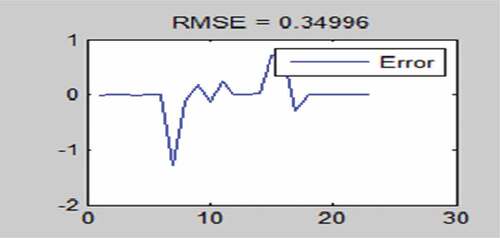
Figure 13. This curve shows the minimum and maximum error and performance evaluation of the testing section
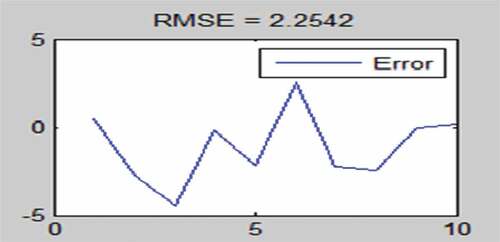
Table 3. Classification of each fifth petechia
Table 4. Classification of 1 mm ≤ ulcer length ≤ 2 mm
Table 5. Classification of 2 mm ≤ ulcer length ≤ 4 mm
Table 6. Classification of 4 mm ≤ ulcer length ≤ 6 mm
Table 7. Classification of ulcer length ≥ 6 mm
Table 8. Comparison of methods
Fuzzy Rules Base: This is an essential portion in the FIS, and in the fuzzy system quality of results depends on rules. In this section, the fuzzy rules base has been developed using the input variables, with “if-then” rules based on what has been demonstrated.
Consider some of the fuzzy rules given as follows:
If (0≤ W1 ≤ 5) and (0≤ W2 ≤ 6) and(0≤ W3 ≤ 4) and (0≤ W4 ≤ 4) and (0≤ W5 ≤ 7) Then (Ulcer Index is Low).
If (5< W1 ≤ 10) and (6< W2 ≤ 10) and(4< W3 ≤ 8) and (4< W4 ≤ 8) and (7< W5 ≤ 14) Then (Ulcer Index is Medium).
If (10≤ W1 ≤ 15) and (10≤ W2 ≤ 14) and(8≤ W3 ≤ 12) and (8≤ W4 ≤ 12) and (W5 > 14) Then (Ulcer Index is High).
…
shows the method of inferring the rules entered into the system by the Sugeno model. The rows indicate the number of rules and the columns indicate the inputs. The red line in each column indicates the activation of the fuzzy sets involved in the rules according to the inputs given to the fuzzy inference system.
3.3. Expert opinion
Physicians need to manually identify features to detect ulcer diseases. The diagnosis process can be manipulated by providing adequate data, experiment and knowledge. Expert opinion is a relatively informal method that can be utilized to serve a variety of requirements and it can be utilized to assist any identification of illness (Morice et al., Citation2014; Tonelli, Citation1999). The experts with advanced knowledge are able to express their scientific-based opinion in a simple probabilistic fashion. In these study tables below were created by medical experts in the field of peptic ulcer issue (). Comparison of achieved results and different membership functions are shown in and respectively.
Table 9. Classification of each fifth petechia
Table 10. Classification of 1 mm ≤ ulcer length ≤ 2
Table 11. Classification of 2 mm ≤ ulcer length ≤ 4 mm
Table 12. Classification of 4 mm ≤ ulcer length ≤ 6
Table 13. Classification of ulcer length ≥ 6 mm
Table 14. Comparison of result
3.4. ROC analysis
Receiver Operating Characteristics (ROC) charts are a clear and useful opportunity to organize classifiers and visualizing their performance (Fawcett, Citation2006; Kannan & Vasanthi, Citation2019). The project began in the 1940s to interpret radio signals, used by radar receivers to analyze radar images during World War II. Since the early 1970s, the ROC has been found to be a useful tool for interpreting the results of medical tests and more. The ROC charts are recently use in medical decision-making and other cases. It has currently been accepted in data mining and machine learning research societies (Slaby, Citation2007).
In order to compare the two mentioned methods, the efficiency of the Fuzzy Expert Systems was evaluated using the ROC curves (Castanho et al., Citation2007; Zolghadri & Mansoori, Citation2007). Three metrics including specificity, sensitivity and area under the curve were applied for evaluation of FCM and ANFIS. Specificity and sensitivity were computed by finding the number of true negatives (TN), true positives (TP), false negatives (FN) and false positives (FP). TNs are correctly detected normalities (non ulcers) while TPs are correctly detected abnormalities (ulcers). FNs and FPs are the numbers of incorrect detections of abnormalities and normalities respectively. The two metrics are calculated as:
Results of the ROC curve for methods are shown in and . The area under the ROC Curve, AUC is commonly used as a summary measure of diagnostic accuracy. According to the results the first curve is the ROC curve for FCM, and it shows an accuracy of 90%. The second curve is the ROC curve for ANFIS showing an accuracy of 85%.
ROC analysis provides accuracy indexes including area under the curve, max sensitivity cut-off point. The summary result of the ROC curves for methods are shown in . According to the results, it can be claimed the FCM Curve is better than the ANFIS curve.
Table 15. Comparison of ROC curves
3.5. Other fuzzy expert systems for diagnosis of disease
Fuzzy Expert Systems have been successfully used not only in health care but also in other areas. For damage detection of regular dams and irregular plates, a new approach has been proposed based on a combination of ANFIS with wavelet transform (Hamidian et al., Citation2018). Several studies on the analysis of the stability and synthesis of control laws have been undertaken for multiple models (Chadli & Borne, Citation2013; Maamri et al., Citation2018). The aims of another study were diagnosing, analyzing and learning the purpose of the prostate cancer diseases using the Fuzzy Expert System. Prostate-specific antigen, age and prostate volume have been considered as input parameters. Prostate cancer risk is the output of the suggested system. In most of the studies the Fuzzy Expert System is mentioned as a rapid, economical, and low risk as a comparison with traditional diagnostic systems (Saritas et al., Citation2003).
In another research, the proposed fuzzy system represented a promising approach for accurate predicting diabetes. The fuzzy verdict mechanism took the information collected from diabetic patients as inputs. Rules and physicians’ knowledge were considered to predict the rate of diabetes. Results showed better accuracy as compared to other prediction approaches (Jain & Raheja, Citation2015).
A prototype expert system in gastroenterology was developed in Itay. This system is capable of assisting physicians in the diagnosis of gastrointestinal disorders. The system consists of approximately 400 rules representing deductive knowledge. The prototype essentially works by doctor keys in the patient symptom data, general information, medical history and physical examination through a user interface. The system responds by identifying the organ and the disease by suggesting clinical examinations. The domain comprises of chronic pathologies of the digestive tract. Consideration has been given to the greater risk illnesses and those most frequently experienced in everyday practice. Knowledge in the scheme is structured as a search-tree of feasible diagnostics, with more general concepts at the top level and more particular concepts at the bottom level. Starting with the initial kernel of the system, errors in the regulations and the search strategy have been recognized by carrying out a sequence of tests on a big amount of already resolved instances related to illnesses in the implemented sub-domain (Terribile et al., Citation1991).
A portable, economic system has been created for cooling the brain as well. This system provides efficacy and safety in porcine models (Bakhsheshi et al., Citation2019). An endoscopy in medicine is a procedure where organs inside the body are looked at using an instrument called an endoscope (a flexible tube with a camera). The emergence of endoscopic imaging techniques allows access to novel developed computer-aided decision support systems (Liedlgruber & Uhl, Citation2011). A neural fuzzy-based evolutionary system has been proposed to diagnose acute abdominal pain without examining a specialist. The acute abdomen may be caused by a vascular occlusion, infection, inflammation or obstruction. The patient is asked by a computer-based diagnostic system as a multi-choice questionnaire. It can help user get accurate information about the diagnosis and treatment of acute pain, including appendicitis, pancreatitis, diverticulitis and obstructive bowel disease (Towell & Shavlik, Citation1994).
Definition functional or nonulcer dyspepsia pain is a term used to describe signs and symptoms of indigestion that have no obvious cause. Helicobacter pylori infection, gastritis, pathology and age are the cause and signs of nonulcer indigestion (Torchio et al., Citation1989). A successful method has been introduced for analysis and classification of symptoms of indigestion for 348 patients with nonulcer indigestion. (Lai et al., Citation1996). Capsule endoscopy or Wireless Capsule Endoscopy (WCE) is a technology developed in medicine that uses a tiny wireless camera to take pictures of the digestive tract, especially the small intestine. WCE as a complete computer-aided diagnostic system showed promising results with a classification accuracy of 91%. This method reduces data retrieval time, and also serves as a tool to help and train inexperienced physicians. (Charisis et al., Citation2013).
Cardiovascular disease affects millions of people annually. The fuzzy soft expert system developed was used to predict coronary artery disease using several symptoms. The fuzzy soft expert system developed could help the expert doctor to decide if drug therapy or intervention is needed (Hassan et al., Citation2017). Farahani et al. proposed a system consists of different modules including working memory, knowledge base, inference engine and user interface. The system took the risk factors and symptoms of lung cancer. In addition, to generate rules, domain expert knowledge was gathered. Type-2 Fuzzy Inference engine fired relevant rules under the appropriate condition and provided the probability of disease as the output of the system. The output of the system as a second opinion could assist physicians (Farahani et al., Citation2015).
Traditional diagnosis in medicine has lower accuracy compared to the combining of health-care with artificial intelligence techniques. The wide acceptance of artificial intelligence in health-care relates to the complexities of modern medicine, which involves the acquisition and analysis of a copious amount of information. Physician decision can be a laborious and error-prone process. Medical artificial intelligence with their advanced computing ability is overcoming this limitation. Artificial intelligence helps physicians around the world make faster and better decisions. In the case of ulcer diseases physician should consider whole peptic ulcer symptoms caused by many other illnesses, such as a stomach virus, weakness, fatigue, vomiting blood and blood in the stool (Hwang et al., Citation2015). However, our suggested method as an economical measurement technique is accurate, rapid and novel to diagnose gastric cancer. It also can provide more data set of peptic ulcer since it can process the length of leisure and ulcer indexes quickly. In Iran, the mortality of stomach cancer is the first cause of death due to cancer in both sexes (Movahedi et al., Citation2009). Using this method gastric cancer can be detected at an early stage. Gastric cancer is the second cause of cancer-related deaths all over the world (Hwang et al., Citation2015). Patients with peptic ulcers and H. Pylori infection have a high risk of gastric cancer development. As the health-care system becomes more expensive and inaccurate, replacing the expensive elements in patient care and computer diagnostic solutions will be desired. Consequently, represented novel Fuzzy Expert System improves reliability, predictability, and consistency with higher quality. It is also patient safety and estimates better medicine cognition in the analysis of complicated peptic ulcer data. However, it is valuable to mention that while the application of computer science in the delivery of health-care has promising potential, some technical and ethical challenges still exist. Medical artificial intelligence in computer science is largely driven by computer scientists without any medical training. So it is strongly recommended to trigger research teamwork projects with technically focused and problem-oriented specialists in both medicine and computer field.
4. Conclusion
One of the important parts of medical science is concerned with disease prediction. Many health-care organizations particularly laboratory results are often associated with inaccurate and uncertain issues. It occurs due to wrong diagnose, medication errors and shortage of physicians compared to the increased number and needs of patients that require care. This has led to the development of computer diagnostic tools to help physicians and professionals to manage uncertainty. Stomach ulcers can be easily cured, but they can become severe without precise diagnosis and proper treatment. The purpose of this study was to propose a reliable Fuzzy Expert System for the diagnosis and prediction of gastrointestinal diseases more accurately and quickly. In this study the powerful fuzzy system allows doctors and patients to more easily access health records and assess patient’s health data that is recorded over a period of time. Furthermore, the Fuzzy Expert System provides information for earlier ulcer cancer diagnoses and shorter time-lines for developing and testing new medications. It can also be used in pharmaceutical industries to speed ulcer drug development and clinical trials. Suggested Fuzzy Expert System can be considered as a unique technique to replace some of the human elements of clinical care. The Fuzzy Expert system in this project sounds promising, but similar health informatics projects are required to evaluate other diseases. Effective communication skills of engineers and physicians are demanded to improve the weak points of medical technology over time. Hopefully, in the near future, Fuzzy Expert System may able to detect ulcer cancer and other diseases earlier than possible via standard diagnostic methods, which could be lifesaving for patients.
Nomenclature
| ANFIS | = | Adaptive Neuro-Fuzzy Inference System |
| BCFP | = | Benefit Maximizing Classifier on Feature Projections |
| CAD | = | Computer Aided Diagnostics |
| FIS | = | Fuzzy Inference System |
| FCM | = | Fuzzy C-Means |
| ROC | = | Receiver Operating Characteristics |
| UI | = | Ulcer Index (mm) |
| W1 | = | Each 5 petechia points were considered as a 1 mm |
| W2 | = | The number of ulcers with lengths from 1 to 2 mm |
| W3 | = | The number of ulcers with lengths from 2 to 4 mm |
| W4 | = | The number of ulcers with lengths from 4 to 6 mm |
| W5 | = | The number of ulcers with lengths from 6 mm and above |
| WCE | = | Wireless Capsule Endoscopy |
Acknowledgements
I would like to acknowledge the staff of the Faculty of Pharmacy, Tehran University of Medical Sciences. We are sincerely thankful to Dr. Bijan Emamipour for his professional advice and support which was a constant source of inspiration.
Additional information
Funding
Notes on contributors

Saeedreza Arab
Saeedreza Arab is a faculty member of the Computer Engineering Department, Higher Education Complex of Bam, Iran. He received a B.Sc. degree in computer science from Shahid Bahonar University, Kerman, Iran, in 2006, and an M.Sc. degree in Information Technology Engineering from Amirkabir University of Technology, Tehran, Iran, in 2011. He is currently a Ph.D. candidate of Information Technology Engineering, Islamic Azad University, Sabzevar, Iran. His main research interests include expert systems, data mining in big data, internet of things (IoT) and wireless sensor networks. He also participated in different national and international conferences, having presentations and posters as well. Several conference articles have been published by him in the field of fuzzy systems, localization in wireless sensor network, IoT and data mining. In this study he focused on designing a fuzzy expert system for the diagnosis of peptic ulcer disease. Designed system has been compared to the medical experts’ knowledge as well as their medical-skills to achieve the best decision in the field of peptic ulcer disease.
References
- Abbass, H. A. (2002). An evolutionary artificial neural networks approach for breast cancer diagnosis. Artificial Intelligence in Medicine, 25(3), 265–23. https://doi.org/10.1016/S0933-3657(02)00028-3
- Abraham, A. (2005). Rule‐based expert systems (Handbook of measuring system design), Wiley Online Library
- Adeli, A., & Neshat, M. (2010). A fuzzy expert system for heart disease diagnosis. In Proceedings of international multi conference of engineers and computer scientists. Hong Kong.
- Aghaei, F., Ross, S. R., Wang, Y., Wu, D. H., Cornwell, B. O., Ray, B., & Zheng, B. (2017, March). Implementation of a computer-aided detection tool for quantification of intracranial radiologic markers on brain CT images. In Medical Imaging 2017: Imaging Informatics for Healthcare, Research, and Applications (Vol. 10138, p. 1013805). International Society for Optics and Photonics
- Bakhsheshi, M. F., Ho, M., Keenliside, L., & Lee, T. Y. (2019). Non-invasive monitoring of brain temperature during rapid selective brain cooling by zero-heat-flux thermometry. Emerging Science Journal, 3(1), 1–9. https://doi.org/10.28991/esj-2019-01163
- Bezdek, J. C., Ehrlich, R., & Full, W. (1984). FCM: The fuzzy c-means clustering algorithm. Computers & Geosciences, 10(2–3), 191–203. https://doi.org/10.1016/0098-3004(84)90020-7
- Castanho, M. J., Barros, L. C., Yamakami, A., & Vendite, L. L. (2007). Fuzzy receiver operating characteristic curve: An option to evaluate diagnostic tests. IEEE Transactions on Information Technology in Biomedicine, 11(3), 244–250. https://doi.org/10.1109/TITB.2006.879593
- Chadli, M., & Borne, P. (2013). Multiple models approach in automation. Takagi-Sugeno Fuzzy Systems, Wiley Online Library.
- Charisis, V. S., Katsimerou, C., Hadjileontiadis, L. J., Liatsos, C. N., & Sergiadis, G. D. (2013, June). Computer-aided capsule endoscopy images evaluation based on color rotation and texture features: An educational tool to physicians. In Proceedings of the 26th IEEE International Symposium On Computer-Based Medical Systems (pp. 203–208). IEEE.
- De Silva, C. W. (2018). Intelligent control: Fuzzy logic applications. CRC press.
- Doi, K. (2007). Computer-aided diagnosis in medical imaging: Historical review, current status and future potential. Computerized Medical Imaging and Graphics, 31(4–5), 198–211. https://doi.org/10.1016/j.compmedimag.2007.02.002
- Donabedian, A. (2005). Evaluating the quality of medical care. The Milbank Quarterly, 83(4), 691–729. https://doi.org/10.1111/j.1468-0009.2005.00397.x
- Farahani, F. V., Zarandi, M. F., & Ahmadi, A. (2015). Fuzzy rule based expert system for diagnosis of lung cancer. In 2015 Annual Conference of the North American Fuzzy Information Processing Society (NAFIPS) held jointly with 2015 5th World Conference on Soft Computing (WConSC). IEEE.
- Fashner, J., & Gitu, A. C. (2015). Diagnosis and treatment of peptic ulcer disease and H. pylori infection. American Family Physician, 91(4), 236–242. https://www.aafp.org/afp/2015/0215/p236.html
- Fawcett, T. (2006). An introduction to ROC analysis. Pattern Recognition Letters, 27(8), 861–874. https://doi.org/10.1016/j.patrec.2005.10.010
- Fried, L. P., Storer, D. J., King, D. E., & Lodder, F. (1991). Diagnosis of illness presentation in the elderly. Journal of the American Geriatrics Society, 39(2), 117–123. https://doi.org/10.1111/j.1532-5415.1991.tb01612.x
- Giger, M., & MacMahon, H. (1996). Image processing and computer-aided diagnosis. Radiologic Clinics of North America, 34(3), 565–596. https://europepmc.org/article/med/8657872
- Güvenir, H. A. (2003). Benefit maximization in classification on feature projections. In Proceedings of the 3rd IASTED International Conference on Artificial Intelligence and Applications, Malaga, Spain, 424–429
- Güvenir, H. A., Emeksiz, N., Ikizler, N., & Örmeci, N. (2004). Diagnosis of gastric carcinoma by classification on feature projections. Artificial Intelligence in Medicine, 31(3), 231–240. https://doi.org/10.1016/j.artmed.2004.03.003
- Hamidian, D., Salajegheh, J., & Salajegheh, E. (2018). Damage detection of irregular plates and regular dams by wavelet transform combined adoptive neuro fuzzy inference system. Civil Engineering Journal, 4(2), 305–319. https://doi.org/10.28991/cej-030993
- Hassan, N., Sayed, O. R., Khalil, A. M., & Ghany, M. A. (2017). Fuzzy soft expert system in prediction of coronary artery disease. International Journal of Fuzzy Systems, 19(5), 1546–1559. https://doi.org/10.1007/s40815-016-0255-0
- Hwang, J. J., Lee, D. H., Lee, A.-R., Yoon, H., Shin, C. M., Park, Y. S., & Kim, N. (2015). Characteristics of gastric cancer in peptic ulcer patients with Helicobacter pylori infection. World Journal of Gastroenterology: WJG, 21(16), 4954. https://doi.org/10.3748/wjg.v21.i16.4954
- Jain, V., & Raheja, S. (2015). Improving the prediction rate of diabetes using Fuzzy Expert System. International Journal of Information Technology and Computer Science, 10(10), 84–91. https://doi.org/10.5815/ijitcs.2015.10.10
- Jang, J. S. (1993). ANFIS: Adaptive-network-based fuzzy inference system. IEEE Transactions on Systems, Man, and Cybernetics, 23(3), 665–685. https://doi.org/10.1109/21.256541
- Kandel, A. (1991). Fuzzy expert systems. CRC press.
- Kannan, R., & Vasanthi, V. (2019). Machine learning algorithms with ROC curve for predicting and diagnosing the heart disease. Soft Computing and Medical Bioinformatics. 63–72. Springer, Singapore. http://doi-org-443.webvpn.fjmu.edu.cn/10.1007/978-981-13-0059-2_8
- Lai, S. T., Fung, K. P., Ng, F. H., & Lee, K. C. (1996). A quantitative analysis of symptoms of non-ulcer dyspepsia as related to age, pathology, and Helicobacter infection. Scandinavian Journal of Gastroenterology, 31(11), 1078–1082. https://doi.org/10.3109/00365529609036890
- Laine, L., & Peterson, W. L. (1994). Bleeding peptic ulcer. New England Journal of Medicine, 331(11), 717–727. https://doi.org/10.1056/NEJM199409153311107
- Lanas, A., & Chan, F. K. (2017). Peptic ulcer disease. The Lancet, 390(10094), 613–624. https://doi.org/10.1016/S0140-6736(16)32404-7
- Liedlgruber, M., & Uhl, A. (2011). A summary of research targeted at computer-aided decision support in endoscopy of the gastrointestinal tract. Department of Computer Sciences, University of Salzburg. Tech. Rep, 1. http://www.cosy.sbg.ac.at/research/tr.html
- Maamri, F., Bououden, S., Chadli, M., & Boulkaibet, I. (2018). The Pachycondyla Apicalis metaheuristic algorithm for parameters identification of chaotic electrical system. International Journal of Parallel, Emergent and Distributed Systems, 33(5), 490–502. https://doi.org/10.1080/17445760.2017.1401622
- Malfertheiner, P., Megraud, F., O’morain, C., Gisbert, J., Kuipers, E., Axon, A., Bazzoli, F., Gasbarrini, A., Atherton, J., & Graham, D. Y. (2017). Management of Helicobacter pylori infection—the Maastricht V/Florence consensus report. Gut, 66(1), 6–30.
- Matthijs, G., Souche, E., Alders, M., Corveleyn, A., Eck, S., Feenstra, I., Race, V., Sistermans, E., Sturm, M., & Weiss, M. (2016). Guidelines for diagnostic next-generation sequencing. European Journal of Human Genetics, 24(1), 2. https://doi.org/10.1038/ejhg.2015.226
- Moghaddam, G., Sharifzadeh, M., Hassanzadeh, G., Khanavi, M., & Hajimahmoodi, M. (2013). Anti-ulcerogenic activity of the pomegranate peel (Punica granatum) methanol extract. Food and Nutrition Sciences, 4(10), 43. https://doi.org/10.4236/fns.2013.410A008
- Morice, A. H., Millqvist, E., Belvisi, M. G., Bieksiene, K., Birring, S. S., Chung, K. F., Dal Negro, R. W., Dicpinigaitis, P., Kantar, A., & McGarvey, L. P. (2014). Expert opinion on the cough hypersensitivity syndrome in respiratory medicine. European Respiratory Journal, 44(5), 1132–1148. https://doi.org/10.1183/09031936.00218613
- Movahedi, M., Afsharfard, A., Moradi, A., Nasermoaddeli, A., Khoshnevis, J., Fattahi, F., & Akbari, M. E. (2009). Survival rate of gastric cancer in Iran. Journal of Research in Medical Sciences: The Official Journal of Isfahan University of Medical Sciences, 14(6), 367. https://www.ncbi.nlm.nih.gov/pmc/articles/PMC3129080/
- Neshat, M., Yaghobi, M., Naghibi, M., & Esmaelzadeh, A. (2008). Fuzzy Expert System design for diagnosis of liver disorders. In 2008 international symposium on knowledge acquisition and modeling, Wuhan, 2008, pp. 252–256, IEEE
- Pena-Reyes, C. A., & Sipper, M. (1999). A fuzzy-genetic approach to breast cancer diagnosis. Artificial Intelligence in Medicine, 17(2), 131–155. https://doi.org/10.1016/S0933-3657(99)00019-6
- Pereira, C. R., Pereira, D. R., Weber, S. A., Hook, C., de Albuquerque, V. H. C., & Papa, J. P. (2019). A survey on computer-assisted Parkinson's disease diagnosis. Artificial intelligence in medicine, 95, 48–63
- Peskar, B. M., Ehrlich, K., & Peskar, B. A. (2002). Role of ATP-sensitive potassium channels in prostaglandin-mediated gastroprotection in the rat. Journal of Pharmacology and Experimental Therapeutics, 301(3), 969–974. https://doi.org/10.1124/jpet.301.3.969
- Quinlan, J. R. (1986). Induction of decision trees. Machine Learning, 1(1), 81–106. https://doi.org/10.1007/BF00116251
- Ramakrishnan, K., & Salinas, R. C. (2007). Peptic ulcer disease. American family physician, 76(7), 1005–1012
- Saritas, I., Allahverdi, N., & Sert, I. U. (2003). A Fuzzy Expert System design for diagnosis of prostate cancer. In Proceedings of the 4th international conference conference on Computer systems and technologies: e-Learning (CompSysTech '03). Association for Computing Machinery, New York, NY, USA, 345–351. https://doi.org/10.1145/973620.973677
- Schwartz, W. B. (1970). Medicine and the computer: The promise and problems of change. In Use and impact of computers in clinical medicine (pp. 321–335). Springer.
- Sittig, D. F., Gardner, R. M., Pace, N. L., Morris, A. H., & Beck, E. (1989). Computerized management of patient care in a complex, controlled clinical trial in the intensive care unit. Computer Methods and Programs in Biomedicine, 30(2–3), 77–84. https://doi.org/10.1016/0169-2607(89)90060-6
- Slaby, A. (2007). ROC analysis with Matlab. In 2007 29th International Conference on Information Technology Interfaces, IEEE, Cavtat, Croatia
- Terribile, C., Marino, P., & Giorgio, I. (1991). A prototype expert system in gastroenterology. In Proceedings of the Annual International Conference of the IEEE Engineering in Medicine and Biology Society Volume 13 : 1991, Orlando, FL, USA, 1991, pp. 1337–1338
- Tonelli, M. R. (1999). In defense of expert opinion. Academic Medicine: Journal of the Association of American Medical Colleges, 74(11), 1187–1192. https://doi.org/10.1097/00001888-199911000-00010
- Torchio, M., Molino, G., Cavanna, A., Appendini, L., & Fornara, A. (1989). PEPTY: A knowledge-based program for assisting medical reasoning in peptic diseases. Computer Methods and Programs in Biomedicine, 28(4), 249–256. https://doi.org/10.1016/0169-2607(89)90158-2
- Towell, G. G., & Shavlik, J. W. (1994). Knowledge-based artificial neural networks. Artificial Intelligence, 70(1–2), 119–165. https://doi.org/10.1016/0004-3702(94)90105-8
- Umashanker, M., & Shruti, S. (2011). Traditional Indian herbal medicine used as antipyretic, antiulcer, anti-diabetic and anticancer: A review. International Journal of Research in Pharmacy and Chemistry, 1(4), 1152–1159.
- Wilson, James Maxwell Glover, Jungner, Gunnar & World Health Organization. (1968). Principles and practice of screening for disease / J. M. G. Wilson, G. Jungner. World Health Organization. https://apps.who.int/iris/handle/10665/37650
- Zadeh, L. A. (1994). Fuzzy logic, neural networks, and soft computing. Communications of the ACM, 37(3), 77–85. https://doi.org/10.1145/175247.175255
- Zolghadri, M. J., & Mansoori, E. G. (2007). Weighting fuzzy classification rules using receiver operating characteristics (ROC) analysis. Information Sciences, 177(11), 2296–2307. https://doi.org/10.1016/j.ins.2006.12.009


